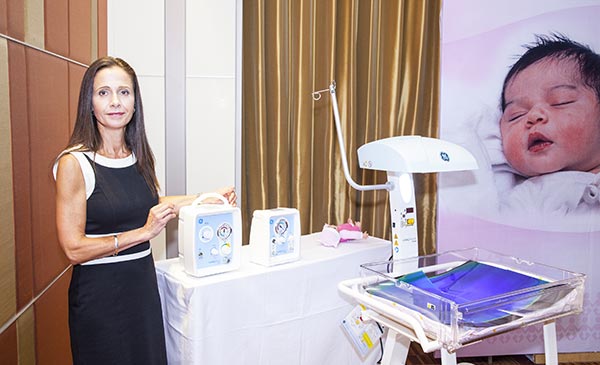GE helps improve access to quality new born care

While the world has made unprecedented progress in tackling maternal and child mortality, the
birthing process continues to be the riskiest day for every newborn. Of the 139 million children born every year in the world, three million die in the first month, two million in the first week and one million are born to die on the same day. In Vietnam, nearly 12,000 babies die each year during childbirth or within the first day each year. In developing nations, where 90 per cent of world’s births occur, warmers, resuscitation devices, and incubators are critical lifesaving devices.
“Innovation is critical to tackle the huge neonatal mortality in Vietnam and around the world, and GE Healthcare is on the frontline of accessible solutions,” said Deborah Mayor, general manager of Maternal Infant Care at GE Healthcare Asia Pacific. “Pre-term births, neonatal hypothermia, birth asphyxia, lack of oxygen circulation and jaundice are some of the largest causes for neonatal morbidity and mortality. These deaths and disabilities formed in the process of survival are preventable with access to quality critical care solutions like infant warmers, resuscitation devices, continuous positive airway pressure (CPAP) or breathing support for under-developed infant lungs and phototherapy devices.”

One of the major contributors to death and illness in infants is hypothermia, a reduction in core body temperature below 35oC. According to the World Health Organization, nearly 20 million low birth weight (LBW) babies are born each year, mostly in the developing world, and these babies are especially prone to hypothermia due to insufficient fat beneath the skin. The new Lullaby Warmer Prime is an easy to use infant warmer that makes reliable thermoregulation accessible for primary care settings even in remote and rural areas. By delivering uniform thermoregulation and consistently maintaining prescribed temperatures, the Lullaby Warmer Prime helps caregivers save precious young lives.
The Lullaby Warmer Prime is designed to operate in tough conditions and is equipped with a re-usable probe made with Kevlar, the same material used in bullet-proof vests, for reliability. The system can work without a voltage stabiliser and has been designed to withstand heavy voltage fluctuations prevalent in rural areas of Vietnam (up to 380V) and has a power consumption of just 154W, which may result in considerable savings.
The first minute after birth is the most critical period for an infant, and hospitals need to be prepared for exigencies like asphyxia caused due to airway blockage. Globally, about one quarter of all neonatal deaths are caused by birth asphyxia. The Lullaby Resus Prime and Lullaby Resus Plus are neonatal resuscitation devices that deliver oxygen simply, are intuitive to operate to accommodate virtually any level of skill, and are compact systems putting lifesaving capabilities right at the bedside.
At least 50 per cent of global births occur in low resource or under-served settings where access to quality infant care remains limited. In Vietnam in particular, the neonatal mortality rate in rural areas is 50 per cent than the rate in urban centres. GE Healthcare’s Lullaby suite of infant care solutions have been developed in India with the help and inputs from primary care and other healthcare professionals.
“The low resource settings need equipment that are easy to use, do not breakdown frequently and can be used with minimal training,” said Mayor. “The equipment also needs to be rugged to handle Vietnam’s conditions of voltage, temperature fluctuations, heat and dust. These solutions are designed to be used in low resource settings and by frontline caregivers and can dramatically improve access to quality care.”
“Helping newborns survive their first day – and their first week – of life represents the greatest challenge in reducing child mortality and meeting the ambitious Millennium Development Goal 4 of reducing infant mortality,” said Mayor. “The primary barrier to using potentially lifesaving equipment is access to appropriate technology especially in low resource settings. We have removed that barrier by designing solutions from the ground up to ensure they impact the quality of care everywhere, are cost-effective and are usable by frontline health workers.”
What the stars mean:
★ Poor ★ ★ Promising ★★★ Good ★★★★ Very good ★★★★★ Exceptional
Latest News
More News
- Addressing Vietnam's energy challenges with aeroderivative gas turbines (February 28, 2023 | 09:33)
- How to sprint ahead in 2023’s worldwide energy priorities (February 08, 2023 | 13:55)
- Boosting Vietnam's grid stability through gas turbine technology (November 22, 2022 | 20:02)
- Healthcare trio collaborates to provide thousands of free breast scans (October 27, 2022 | 17:19)
- GE Healthcare's vision for AI-backed radiology (September 29, 2022 | 11:53)
- GE brand trio to shape the future of key industries (July 19, 2022 | 15:35)
- GE unveiling brand names and defining future (July 19, 2022 | 15:16)
- GE: the shortest route towards sustainability (July 18, 2022 | 08:00)
- Be proactive in an uncertain world (May 20, 2022 | 11:40)
- GE secures first 9HA combined cycle power plant order in Vietnam (May 16, 2022 | 17:06)

















 Mobile Version
Mobile Version